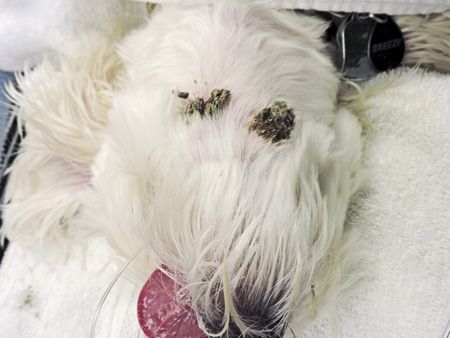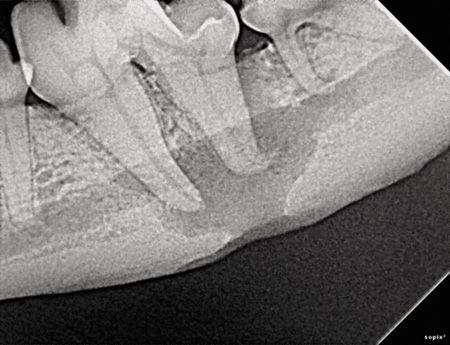Image Quiz: Submandibular draining tracts in a Maltese mix
Scan the photos, spot the answer and save the patient.
A 4-year-old spayed female Maltese mix was presented for chronic bilateral draining tracts and swelling below the mandibles. Treatment with multiple courses of antibiotics was not successful in resolving the lesions. An oral examination revealed some abnormalities with the shape and crowns of the mandibular first molars.

1. Bilateral chronic draining tracts on the ventral aspect of the lower jaw.

2. Crown shape and surface abnormalities of the left mandibular first molar. The same abnormalities were noted on the right.

3. The normal first mandibular molar roots are divergent. After elevation of a mucogingival flap and lateral alveolar bone removal, these tooth roots appear to be converging.

4. A dental radiograph of left mandibular first molar (309).

5. A dental radiograph of right mandibular first molar (409).
Which of the following is the most likely diagnosis?
a) Rubber jaw
b) Carious lesions of the first mandibular molars
c) Dens invaginatus
d) Complicated crown fractures of 309 and 409
e) Neoplasia
Answer
c) Dens invaginatus
Dens invaginatus is a developmental abnormality in which the enamel organ infolds back into the tooth as the permanent tooth is forming. These teeth often have dentin exposure and do not have normal root canal systems, and pulp necrosis occurs soon after eruption.
A histopathologic examination is needed to definitively diagnose the condition, but the appearance of the crown, root and endodontic system can provide strong support for the diagnosis of dens invaginatus. Abnormalities of the crown can be evident, and enamel may be rough or irregular in the area of the furcation.
Radiographs reveal that the roots are converging together instead of diverging as they normally would. The endodontic system may also be difficult to define or may be obstructed in areas.
Treatment options include endodontic treatment or extraction. Endodontic treatment can be challenging since often the root canal system is not normal and the canals can be difficult to navigate and treat effectively. If you suspect this condition in a patient, endodontic therapy can be initiated to prevent pulp death and subsequent infection.
In this case, there is significant periapical bone loss due to the chronic infection. Careful extraction of these teeth is warranted to prevent pathologic mandibular fracture.
The prognosis is good for stability and strength of the mandible once bony healing occurs. Use of a bone graft in the alveolus may help facilitate the healing process.
Kendall Taney, DVM, DAVDC, is a partner at the Center for Veterinary Dentistry and Oral Surgery in Gaithersburg, Maryland.